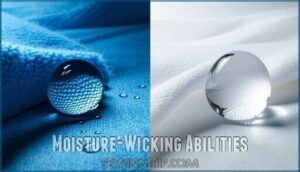This site is supported by our readers. We may earn a commission, at no cost to you, if you purchase through links.
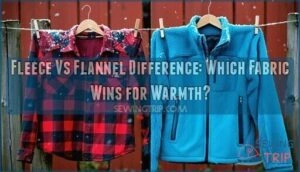
Fleece offers exceptional moisture-wicking and durability, making it perfect for outdoor activities and athletic wear. It resists tears and won’t fray at edges. Flannel provides breathable warmth and soft comfort, ideal for pajamas and bedsheets.
While fleece manages moisture better, flannel feels gentler against sensitive skin. Both fabrics deliver warmth, but through different mechanisms—fleece traps air in synthetic fibers while flannel’s brushed natural surface creates cozy insulation.
The manufacturing processes create distinct performance characteristics that affect your comfort.
Table Of Contents
- Key Takeaways
- Fleece Vs Flannel: Key Differences
- Softness and Comfort Compared
- Durability and Longevity
- Breathability and Moisture Control
- Care, Cleaning, and Maintenance
- Environmental Impact and Sustainability
- Popular Products: Fleece and Flannel
- Choosing The Right Fabric for You
- Frequently Asked Questions (FAQs)
- Conclusion
Key Takeaways
- Material composition determines performance: You’ll find fleece uses synthetic polyester fibers that resist moisture and dry quickly, while flannel relies on natural cotton or wool that breathes better but absorbs dampness.
- Durability favors fleece for active use: You’ll get better tear resistance and longevity from fleece’s synthetic construction, though it pills more than flannel’s natural fibers that feel gentler on sensitive skin.
- Climate needs guide your choice: You’ll want fleece for temperatures below 50°F and outdoor activities since it retains warmth when wet, while flannel works best in 55-70°F ranges for breathable comfort.
- Care requirements differ significantly: You’ll find fleece offers wash-and-wear convenience with cold water and low heat drying, while flannel needs more careful handling to prevent shrinkage and maintain its soft texture.
Fleece Vs Flannel: Key Differences
When you’re shopping for warm fabrics, you’ll encounter two popular choices that seem similar but work very differently. Fleece uses synthetic polyester fibers while flannel relies on natural cotton or wool, creating distinct differences in how they feel, perform, and last over time.
Material Composition
Understanding fiber types is essential when choosing between fleece and flannel. Polyester fleece dominates synthetic materials, while cotton flannel leads natural fibers. These fabric blends create different performance characteristics through distinct textile science approaches. The choice between fleece and flannel also depends on warmth comfort needs.
| Aspect | Fleece | Flannel |
|---|---|---|
| Primary Material | 100% polyester (most common) | 80-100% cotton |
| Blend Options | Cotton fleece, spandex blends | Cotton-wool, synthetic mixes |
| Fiber Source | Petroleum-based synthetic fabric | Plant/animal-derived natural fibers |
Fleece fabric composition centers on polyethylene terephthalate, creating hydrophobic properties. Cotton fleece offers natural alternatives, while fleece material engineering focuses on moisture resistance and quick-drying capabilities.
Manufacturing Process
When you compare fabric production methods, fleece fabric follows a straightforward synthetic route, while flannel takes the natural fiber path. Polyester fleece starts with petroleum-based materials that undergo yarn manufacturing, then gets brushed during finishing techniques to create that fluffy texture. Flannel begins with cotton or wool through traditional textile engineering processes.
| Process Stage | Fleece Fabric | Flannel Fabric |
|---|---|---|
| Material Sourcing | Petroleum derivatives | Cotton/wool fibers |
| Yarn Manufacturing | Synthetic spinning | Natural fiber spinning |
| Textile Engineering | Knitted construction | Woven structure |
| Finishing Techniques | Brushing for pile | Napping for softness |
| Final Product | Micro fleece varieties | Brushed cotton/wool |
The manufacturing differences explain why sewing fleece fabric feels different from working with flannel—one’s engineered for synthetic performance, the other crafted from nature’s materials.
Common Uses
You’ll find fleece and flannel serving different purposes in your daily life. Fleece dominates outdoor apparel and athletic wear, while flannel works better for home decor and casual comfort items.
| Fleece Applications | Flannel Applications |
|---|---|
| Fleece Outerwear & jackets | Bedsheets & pillowcases |
| Cold Weather Gear | Pajamas & sleepwear |
| Winter Accessories | Button-up shirts |
| Crafting Projects | Blankets & throws |
Softness and Comfort Compared
You’ll notice significant differences when comparing fleece and flannel for softness and comfort. Each fabric offers unique textures that affect how they feel against your skin and retain body heat.
Your skin will immediately notice the difference between fleece’s plush synthetic pile and flannel’s smooth brushed cotton surface
Texture and Feel
In terms of fabric softness, fleece fabric feels plush and velvety thanks to its deep pile thickness and synthetic yarn texture. Flannel offers a smooth, brushed surface with tighter weave patterns that create gentle warmth. Microfleece provides lightweight comfort, while flannel’s material density gives substantial coziness. Both textures feel inviting, though fleece is often more cushioned and breathable.
Skin Sensitivity
People with sensitive skin often find fleece fabric composition more problematic than flannel. Synthetic fleece can trap heat and moisture, creating irritation factors that cause discomfort.
Natural flannel offers better breathability and lightweight comfort for those with allergy concerns. The vegan polyester in fleece may trigger dermatological impact issues, while cotton flannel usually provides better itch relief and reduces skin reactions.
Warmth Retention
Beyond simple warmth, fleece delivers outstanding thermal insulation through its synthetic fiber construction, which traps air pockets for remarkable heat retention. Unlike flannel’s breathable cotton weave, thermal fleece creates a lightweight barrier that maintains warmth retention even in cold weather conditions. The fabric density of fleece makes it ideal for winter layering, offering insulation without bulk.
Durability and Longevity
When you’re investing in bedding or clothing, you want fabrics that’ll last through countless washes and years of use. Both fleece and flannel have different strengths in terms of standing up to daily wear, but understanding their durability differences can help you make the right choice for your needs.
Wear and Tear Resistance
Fabric durability separates champions from casualties in the textile world. Fleece fabric demonstrates exceptional tear strength compared to flannel, thanks to its synthetic polyester construction that resists stretching and breaking under stress.
Here’s how these materials handle everyday wear:
- Abrasion resistance – Fleece fabric quality shines through repeated washing cycles, while cotton flannel fibers weaken faster with friction
- Fraying prevention – Fleece’s knitted structure prevents edge unraveling, unlike flannel’s woven edges that require hemming
- Material longevity – Fleece properties include resistance to holes and tears, outlasting natural fiber alternatives in high-use applications
Pilling and Shrinkage
Fleece fabric quality varies substantially in terms of pilling resistance and shrinkage control. You’ll find that fleece generally pills more than flannel, with ratings of 3-4 after 500 cycles. However, antipill fleece and microfleece offer improved fiber stability.
Cotton-blend fleece shrinks 3-5% initially, while 100% polyester maintains better textile longevity through proper fleece fabric care.
The demand for high-quality fleece fabrics is driven by the growing market for anti pilling fabrics.
Maintenance Needs
Care requirements differ substantially between these materials, affecting your long-term satisfaction. Fleece offers low-maintenance convenience with simple washing tips: use cold water and gentle cycles. Its breathable synthetic fibers resist shrinking, while drying methods require low heat to preserve insulation quality.
Flannel demands more attention—hot water causes shrinkage, and fabric softening helps maintain texture. For stain removal, fleece manages spills better than flannel’s natural fibers. Storage advice remains similar for both fabrics.
Understanding fabric requirements is vital for sewing projects, considering factors like fabric yardage calculations to guarantee the right amount of material.
Breathability and Moisture Control
When you’re choosing between fleece and flannel for bedding or clothing, breathability becomes a vital factor that can make or break your comfort.
Understanding how each fabric manages moisture and airflow will help you pick the right material for your sleep style and climate needs.
Moisture-Wicking Abilities
When comparing these two wicking materials, fleece clearly outperforms flannel in moisture transfer. Polyester fleece’s hydrophobic structure creates exceptional water repellency, while cotton flannel absorbs and retains dampness against your skin.
Here’s how these breathable fabrics handle moisture:
- Drying Speed – Fleece dries 30-60% faster than flannel under identical conditions
- Moisture Management – Lightweight fleece pulls sweat away through capillary action
- Thermal Regulation – Fleece maintains insulation even when damp
- Breathable Performance – Synthetic fibers prevent moisture absorption, reducing discomfort
Suitability for Hot or Cold Sleepers
Your sleep temperature preferences determine which fabric suits you best. If you’re a cold sleeper who struggles with body heat retention, fleece properties provide exceptional insulation and temperature regulation during cold weather conditions. Hot sleepers benefit from flannel’s breathability, which prevents overheating in hot weather.
Fleece’s lightweight synthetic fibers trap warmth effectively, while flannel’s natural cotton allows better sleep comfort through improved heat dissipation.
Airflow and Ventilation
Proper airflow makes the difference between restful sleep and tossing around all night. Flannel’s natural cotton fibers create loose weave patterns that promote excellent ventilation systems, allowing air to circulate freely through the fabric. This airflow movement helps regulate your body temperature naturally.
Fleece, while warm, can trap air too effectively, reducing breathability. For mid layer insulation, fleece works great, but flannel wins for thermal regulation during sleep.
Care, Cleaning, and Maintenance
You’ll want to understand how fleece and flannel handle different cleaning approaches since their synthetic and natural fibers require distinct care methods.
Proper maintenance affects both fabrics’ lifespan, but fleece generally offers more forgiving wash-and-wear convenience compared to flannel’s delicate requirements.
Washing Instructions
When washing fleece and flannel fabrics, you’ll want to treat them with care to maintain their quality and longevity. Cold water washing preserves fabric integrity, while the gentle cycle prevents damage to delicate fibers.
- Use cold water exclusively – hot water can damage fleece fabric composition and cause flannel shrinkage
- Select gentle cycle settings to protect fleece fabric types and maintain fleece fabric quality
- Skip fabric softener completely as it clogs fleece fibers and reduces moisture-wicking properties
- Apply stain removal techniques immediately using mild detergent and cold water pre-treatment
- Separate fleece vs wool items since different fleece fabric care requirements prevent cross-contamination
Understanding proper fleece washing tips is essential for maintaining the fabric’s quality and longevity.
Drying and Storage
After washing fleece and flannel properly, you’ll need smart drying and storage approaches. Air-drying prevents fabric shrinkage in both materials, while low-heat machine drying works for fleece fabric care. Your storage tips should include proper folding techniques to maintain fleece properties and flannel’s natural fibers.
| Aspect | Fleece | Flannel |
|---|---|---|
| Drying Methods | Low heat or air dry | Air dry preferred |
| Fabric Shrinkage Risk | Minimal with proper care | High with heat |
| Storage Tips | Fold loosely, avoid compression | Breathable storage bags |
| Moisture Control | Quick-drying synthetic | Needs complete drying |
Different fleece fabric types require specific folding techniques—micro fleece needs gentle handling, while sherpa varieties can handle standard folding. Always make certain complete moisture control before storing either material to prevent mildew growth.
Stain and Odor Resistance
Fleece fabric naturally repels many stains due to its synthetic polyester construction, making spill cleanup easier than cotton flannel. However, fleece properties can trap odors more readily, requiring specific fabric treatment approaches.
For effective stain removal, you’ll want cold water and gentle detergents. Odor control works best with enzyme-based cleaning methods that break down bacteria.
While fleece offers decent water resistance against light spills, flannel absorbs liquids quickly but releases odors faster during washing. Effective fleece care often involves using a stain remover product to maintain its quality and appearance.
Environmental Impact and Sustainability
You’ll want to take into account the environmental footprint when choosing between these two fabrics, especially since fleece’s synthetic nature creates different sustainability challenges than flannel’s natural fibers.
While fleece offers recycled options and durability, it releases microplastics during washing, whereas flannel provides biodegradable alternatives but requires more resource-intensive production processes.
Natural Vs Synthetic Fibers
Understanding fiber sources helps you make informed choices between these fabrics. Flannel comes from natural material origins like cotton and wool, offering biodegradable options that break down naturally. Polyester fleece relies on synthetic production from petroleum-based chemicals.
While organic material flannel provides vegan alternatives when cotton-sourced, fleece offers consistent performance through controlled manufacturing processes.
Eco-Friendly Options
You’ll find better choices by selecting organic cotton flannel or hemp-based alternatives instead of synthetic options. These sustainable materials offer biodegradable alternatives that won’t harm waterways.
Look for recycled textiles in fleece fabric composition, which transforms plastic bottles into cozy garments. Vegan fleece made from organic material provides warmth without animal products, supporting green production methods that benefit both you and the planet.
Choosing fabrics with sustainable certifications can help reduce environmental impact and promote eco-friendly practices.
Microplastics and Biodegradability
Microplastic pollution becomes a major concern when you wash synthetic fibers like polyester fleece. Each wash cycle releases up to 1,900 microfibers into waterways, persisting for hundreds of years.
Cotton flannel offers biodegradable materials that break down naturally within months. Eco-friendly fabrics made from natural cotton fleece provide safer alternatives to traditional fleece fabric composition without contributing to microplastic release.
Popular Products: Fleece and Flannel
You’ll find countless fleece and flannel products on store shelves, each designed to tackle different warmth and comfort needs. **Here’s how three popular items stack up against each other in real-world performance.
Southpole Black Marled Fleece Jogge
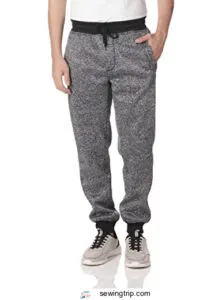
Now that we’ve covered sustainability concerns, let’s look at specific products that showcase fleece fabric’s practical applications. You’ll find the Southpole Black Marled Fleece Joggers represent modern athletic wear trends perfectly, combining comfort with style.
Here’s what makes these fleece joggers stand out:
- Marled fabric texture creates visual depth while maintaining polar fleece warmth
- Black color options offer versatility for various outfits and activities
- Fleece weight comparison shows lighter construction than traditional fleece jackets
- Athletic wear trends favor this relaxed-fit fleece jogger style
- Fleece clothing design balances breathability with insulation properties
These joggers demonstrate how fleece fabric evolves beyond basic sweatpants, offering both functionality and fashion appeal. The various types of fleece used in clothing design contribute to their unique characteristics and uses.
Wrangler Flannel Shirt Jacket
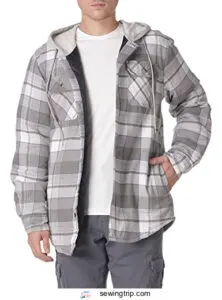
This multifaceted Outerwear combines Flannel Style with quilted lining for Winter Apparel. The brushed flannel exterior and polyester interior create perfect Jacket Materials for Outdoor Clothing. Heavyweight construction with diamond quilted padding guarantees Wrangler Fit meets Outerwear Trends.
You’ll find this flannel jacket beats standard fleece for durability while maintaining classic flannel comfort that conforms to your active lifestyle.
Carter’s Toddler Boys’ Fleece Pajamas
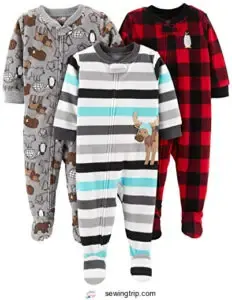
Carter’s Toddler Boys’ Fleece Pajamas represent the highest standard for nighttime comfort. These polar fleece garments deliver exceptional Kids Comfort through synthetic fibers that trap body heat while remaining breathable. Parents appreciate fleece fabric’s durability and easy care requirements.
Why fleece pajamas win hearts:
- Machine-washable convenience – No special care needed for busy families
- Pill-resistant construction – Maintains softness wash after wash
- Hypoallergenic properties – Safe for sensitive skin and Pajama Safety standards
The synthetic blend in Fleece Clothing offers consistent warmth without the bulk of traditional materials. Unlike cotton alternatives, these fleece types resist shrinkage and maintain their shape. This makes them perfect for active toddlers who need reliable Toddler Sleepwear that moves with them throughout the night, aligning with current Childrenswear Trends toward functional comfort.
Choosing The Right Fabric for You
Selecting between fleece and flannel depends on your specific needs, climate, and personal comfort preferences. Consider your budget, intended use, and whether you prioritize synthetic durability or natural breathability when making your choice.
Climate and Use Case
Your climate dictates fabric choice. Fleece dominates in temperatures below 50°F, excelling as an outer layer or mid layer in cold weather conditions. Its weight varies for different winter sports and outdoor activities. Flannel works best from 55-70°F for seasonal clothing needs.
Consider your local climate and specific outdoor activities when selecting cold weather gear for effective temperature control. When choosing fleece, understanding fleece jacket options is essential for making an informed decision.
Budget Considerations
Your wallet’s well-being depends on understanding the cost comparison between these fabrics. Fleece material, particularly polyester fleece, usually costs less due to mass production, while premium flannel commands higher price factors.
- Wholesale fleece fabric offers bulk savings for crafters and businesses
- Budget Options include basic polyester fleece under $10 per yard
- Fleece fabric composition affects pricing – blends cost more than pure synthetic
- Affordable Alternatives feature recycled fleece at competitive rates
- Fabric Costs for flannel range $15-40+ per yard for quality cotton
When choosing between fleece and flannel, considering affordable fabric options can substantially impact your overall sewing budget.
Personal Preferences
Your personal preferences matter most when choosing between fleece and flannel fabrics. Consider your style choices and color preferences alongside fabric feel requirements. If you prefer breathable materials for active lifestyles, flannel suits seasonal needs better. However, fleece jackets excel for outdoor adventures.
| Factor | Fleece Fabric | Flannel |
|---|---|---|
| Style Choices | Modern, athletic look | Classic, rustic appeal |
| Color Preferences | Vibrant, fade-resistant | Earth tones, patterns |
| Fabric Feel | Smooth, synthetic texture | Soft, natural brushed feel |
| Seasonal Needs | Year-round versatility | Fall/winter warmth |
| Lifestyle Considerations | Active, outdoor activities | Cozy, indoor comfort |
Frequently Asked Questions (FAQs)
What is the difference between fleece and flannel hoodies?
You’ll find fleece hoodies wrap you in synthetic warmth like a cozy cocoon, while flannel hoodies breathe naturally with cotton’s gentle embrace, offering different comfort experiences.
What is the difference between fleece and flannel jackets?
Fleece jackets use synthetic polyester fibers that trap heat effectively, making them warmer but less breathable.
Flannel jackets feature natural cotton or wool fibers that breathe better, wick moisture, but provide moderate warmth for layering.
What is the difference between fleece and flannel pants?
While both keep you cozy, synthetic fleece pants trap more heat and dry faster, whereas natural flannel pants breathe better and feel softer against your skin.
What is the difference between fleece and flannel pajamas?
You’ll stay warmer in fleece pajamas since they’re made from synthetic polyester that traps heat effectively. Flannel pajamas, crafted from cotton or wool, breathe better and wick moisture away naturally.
What is the difference between fleece and flannel bedding?
Synthetic fleece traps heat better but may cause overheating, while cotton flannel breathes naturally and wicks moisture. You’ll sleep warmer with fleece, cooler with flannel’s breathable fibers.
Can fleece cause allergic reactions or irritation?
Like a gentle whisper against sensitive skin, synthetic materials can sometimes trigger reactions. You might experience mild irritation if you’re sensitive to polyester or chemical treatments used in fleece production, though true allergies remain uncommon.
Which fabric is better for baby clothing?
Flannel’s your go-to choice for baby clothing. Its natural cotton fibers breathe better than synthetic fleece, reducing overheating risks. You’ll find flannel gentler on sensitive skin, while fleece might trap moisture and cause irritation.
Do fleece and flannel attract pet hair?
Pet hair clings like velcro to both fabrics, but fleece’s synthetic fibers create stronger static that traps fur more aggressively than flannel’s natural weave.
Which material works better for outdoor activities?
You’ll find fleece excels for outdoor activities because it retains warmth even when wet, dries quickly, and wicks moisture effectively.
Flannel absorbs moisture and loses insulation when damp, making it unsuitable for active pursuits.
How do costs compare between fleece flannel?
Your wallet will thank you when choosing fleece over flannel. Fleece usually costs less due to mass-produced synthetic fibers, while high-end flannel commands premium prices from quality cotton or wool processing.
Conclusion
Coincidentally, both fabrics excel at keeping you warm, but the fleece vs flannel difference comes down to your specific needs.
Choose fleece if you’re active outdoors, need moisture-wicking properties, or want easy-care durability. Pick flannel when you prioritize breathable comfort, natural fibers, or cozy sleepwear.
Your lifestyle, climate, and personal preferences will determine which fabric wins for your warmth requirements.
- https://docs.google.com/forms/d/1GAQr3Kn1cURCVHUA82hAga1Wv8DCH0IuqDLRUrOpN7M/viewform?ts=63f4f653&entry.1515682415=https://www.merriam-webster.com/dictionary%2Ffleece
- https://premium.britannica.com/mw-unabridged/?utm_source=mw&utm_medium=inline-def&utm_campaign=evergreen
- https://searchforfabric.com/blogs/search-for-fabric-blog/discover-the-best-fleece-fabric-types-for-every-project
- https://fabriclore.com/blogs/fabric-wiki/information-about-fleece-fabric
- https://puffy.com/blogs/best-sleep/flannel-vs-fleece-blanket





